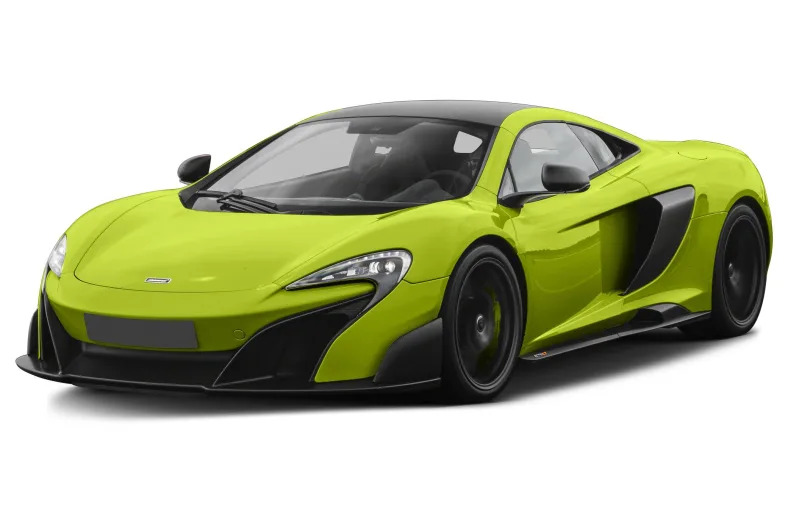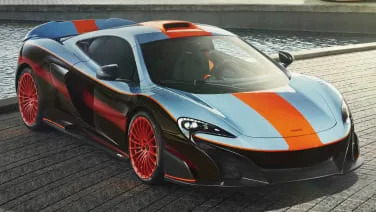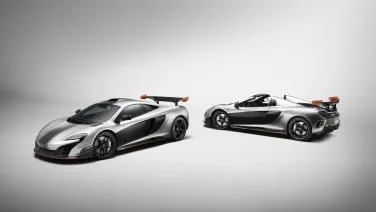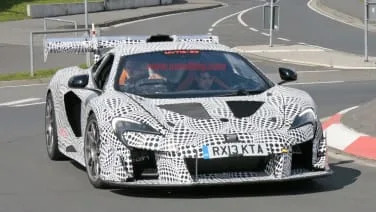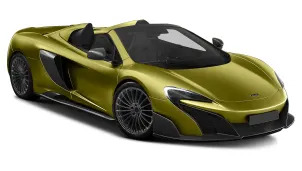Base Rear-Wheel Drive Coupe
2016 McLaren 675LT
"It's so comfortable." That's always the first or second comment made by anyone who owns or has driven a McLaren. They say the coupe or spider in question is also a singular performer, but what really blows them away is the bug-in-a-rug coziness when they're not murdering the tires. A Southern California dealer commenting on the respective driving habits of Ferrari, Lamborghini, and McLaren purchasers said, "McLaren owners drive their cars too much," adding that it wasn't unusual for him to see examples clock 20,000 miles a year or go on long road trips – kind of like the one my colleague Steven Ewing did in a 650S Spider. We spent a week with a Napier Green 675LT coupe, the limited-edition, track-focused model in the Super Series line-up. It establishes a psychic connection with the McLaren F1 GTR Long Tail developed in 1996 to battle the Mercedes-Benz CLK GTR and Porsche 911 GT1. This is what you should know about the 675LT: it's really, really comfortable. Almost excessively so. Final output is 666 hp and 516 lb-ft of torque, an increase of 25 hp and 16 lb-ft over the 650S. At heart is the twin-turbo 3.8-liter V8 found in all McLaren models, but more than half of its components are new for this application. The camshaft is new, the block gets lightweight connecting rods, the fuel pump is upgraded, the twin turbos are the same size as those on the 650S' engine yet more efficient. Final output is 666 horsepower and 516 pound-feet of torque, an increase of 25 hp and 16 lb-ft over the 650S. More important is the weight loss. At 2,712 pounds the 675LT is 220 pounds lighter than a 650S through major overtures like carbon fiber body panels, less sound deadening, Alcantara in the cabin instead of carpet and leather, and a polycarbonate engine cover. You need a special tool – made of carbon fiber – to remove the polycarbonate cover because the struts and latches have been omitted to save weight. Then there are minute gestures, like the windshield being one millimeter thinner (saving 6.6 pounds), the rear bulkhead glass being half a millimeter thinner (saving 1.1 pounds), and the carbon fiber being satin-finished instead of gloss-finished (saving 50 grams). For all that precision, the 0-60 mile-per-hour time of 2.8 seconds is only one tenth under that of the 650S, and its top speed is 205 mph, compared to the 207-mph terminal velocity of the 650S. There is nothing riveting about the 675LT at road-legal speeds on straight roads. But hole shots aren't the point – the mission here is to be the quickest thing around a track. Achieving that goal starts with the bodywork, optimized to deliver 40 percent more downforce than the 650S with help from an 80-percent larger front splitter, a 20-millimeter lower front ride height to increase airflow speed under the coupe, a larger rear diffuser, and new rear fenders, deck, and lower bodysides. Everything aft of the B-pillars is specific …
Full Review
"It's so comfortable." That's always the first or second comment made by anyone who owns or has driven a McLaren. They say the coupe or spider in question is also a singular performer, but what really blows them away is the bug-in-a-rug coziness when they're not murdering the tires. A Southern California dealer commenting on the respective driving habits of Ferrari, Lamborghini, and McLaren purchasers said, "McLaren owners drive their cars too much," adding that it wasn't unusual for him to see examples clock 20,000 miles a year or go on long road trips – kind of like the one my colleague Steven Ewing did in a 650S Spider. We spent a week with a Napier Green 675LT coupe, the limited-edition, track-focused model in the Super Series line-up. It establishes a psychic connection with the McLaren F1 GTR Long Tail developed in 1996 to battle the Mercedes-Benz CLK GTR and Porsche 911 GT1. This is what you should know about the 675LT: it's really, really comfortable. Almost excessively so. Final output is 666 hp and 516 lb-ft of torque, an increase of 25 hp and 16 lb-ft over the 650S. At heart is the twin-turbo 3.8-liter V8 found in all McLaren models, but more than half of its components are new for this application. The camshaft is new, the block gets lightweight connecting rods, the fuel pump is upgraded, the twin turbos are the same size as those on the 650S' engine yet more efficient. Final output is 666 horsepower and 516 pound-feet of torque, an increase of 25 hp and 16 lb-ft over the 650S. More important is the weight loss. At 2,712 pounds the 675LT is 220 pounds lighter than a 650S through major overtures like carbon fiber body panels, less sound deadening, Alcantara in the cabin instead of carpet and leather, and a polycarbonate engine cover. You need a special tool – made of carbon fiber – to remove the polycarbonate cover because the struts and latches have been omitted to save weight. Then there are minute gestures, like the windshield being one millimeter thinner (saving 6.6 pounds), the rear bulkhead glass being half a millimeter thinner (saving 1.1 pounds), and the carbon fiber being satin-finished instead of gloss-finished (saving 50 grams). For all that precision, the 0-60 mile-per-hour time of 2.8 seconds is only one tenth under that of the 650S, and its top speed is 205 mph, compared to the 207-mph terminal velocity of the 650S. There is nothing riveting about the 675LT at road-legal speeds on straight roads. But hole shots aren't the point – the mission here is to be the quickest thing around a track. Achieving that goal starts with the bodywork, optimized to deliver 40 percent more downforce than the 650S with help from an 80-percent larger front splitter, a 20-millimeter lower front ride height to increase airflow speed under the coupe, a larger rear diffuser, and new rear fenders, deck, and lower bodysides. Everything aft of the B-pillars is specific …
Hide Full Review
Hide Full Review
Retail Price
$349,500
MSRP / Window Sticker Price
| Engine | 3.8L V-8 |
| MPG | |
| Seating | 2 Passengers |
| Transmission | Seamless Shift Gearbox 7-spd auto-shift man w/OD |
| Power | 666 @ 7100 rpm |
| Drivetrain | rear-wheel |
Smart Buy Program is powered by 

